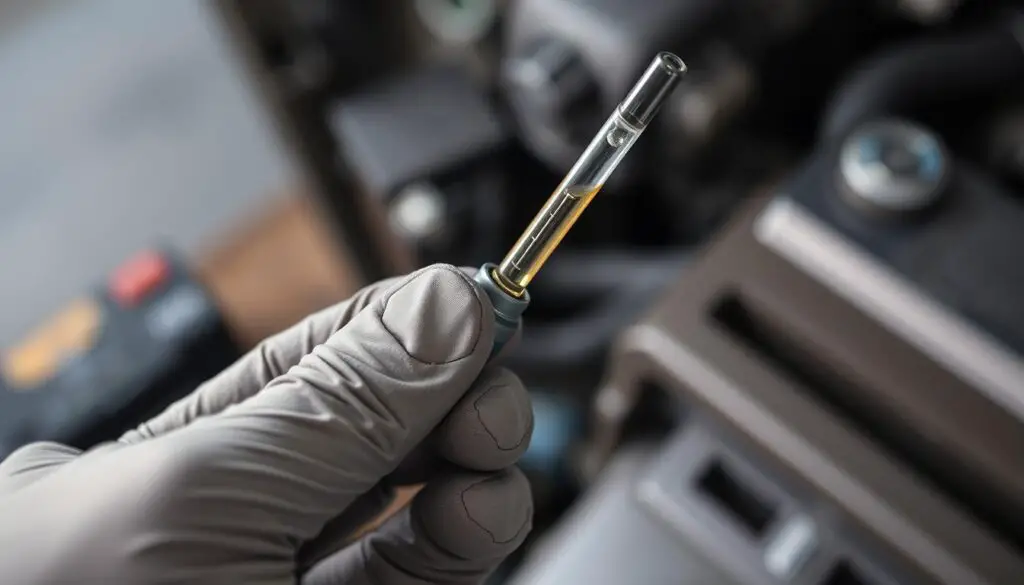Maintaining the transmission fluid level in your Honda Accord is crucial for the longevity and performance of your vehicle. The transmission fluid plays a vital role in lubricating the transmission components, regulating temperature, and facilitating smooth gear shifts.
Neglecting to check and maintain the proper transmission fluid level can lead to serious issues, including premature wear on transmission components, decreased fuel efficiency, and potentially costly repairs.
Fortunately, checking the transmission fluid on your Honda Accord is a relatively straightforward process that can be done at home with a few simple steps.
Key Takeaways
- Regularly checking transmission fluid is essential for maintaining your Honda Accord’s performance.
- Proper transmission fluid level ensures smooth gear shifts and prevents premature wear.
- Neglecting transmission fluid checks can lead to costly repairs.
- Checking transmission fluid is a simple process that can be done at home.
- Maintaining the correct transmission fluid level improves fuel efficiency.
The Importance of Transmission Fluid in Your Honda Accord
In your Honda Accord, transmission fluid is essential for lubricating moving parts, regulating temperature, and facilitating smooth gear shifting. This fluid is the lifeblood of the transmission system, ensuring that all components work together seamlessly.
What Transmission Fluid Does
Transmission fluid serves several critical functions in your Honda Accord. It lubricates moving parts within the transmission, reducing friction and preventing wear. Additionally, it helps regulate the transmission’s operating temperature, preventing overheating. Lastly, transmission fluid enables smooth gear shifting, ensuring a comfortable driving experience.

Signs of Low or Degraded Transmission Fluid
Low or degraded transmission fluid can manifest in several ways. Common signs include slipping gears, unusual noises, or rough shifting. If you notice any of these symptoms, it’s crucial to check your transmission fluid level and condition promptly.
Consequences of Neglecting Fluid Maintenance
Neglecting transmission fluid maintenance can lead to severe consequences, including premature wear on transmission components, increased risk of transmission failure, and costly repairs. Regular checks and maintenance can prevent these issues, ensuring your Honda Accord’s transmission operates smoothly for years to come.
Tools and Materials Needed
To check the transmission fluid level in your Honda Accord, you’ll first need to gather a few essential tools and the correct type of transmission fluid. Ensuring you have the right materials will make the process smoother and help you avoid potential pitfalls.
Essential Tools for Checking Fluid
The primary tool needed is the transmission dipstick, which is used to check the fluid level. You’ll also need a lint-free rag to wipe the dipstick clean before reinserting it to get an accurate reading.
Recommended Transmission Fluid Types for Honda Accord
Honda Accord models vary in their transmission fluid requirements depending on whether they have an automatic, manual, or CVT transmission.
Automatic Transmission Fluid Specifications
For Honda Accords with automatic transmissions, Honda recommends using Honda ATF DW-1 or an equivalent. Using the wrong type of fluid can lead to decreased performance and potentially damage your transmission.
CVT Fluid Specifications
For models equipped with CVT transmissions, Honda specifies the use of Honda CVT Fluid or an equivalent. CVT fluid is designed to meet the unique demands of continuously variable transmissions.
| Transmission Type | Recommended Fluid |
|---|---|
| Automatic | Honda ATF DW-1 |
| CVT | Honda CVT Fluid |
As emphasized by Honda, “Using the correct transmission fluid is crucial for maintaining the performance and longevity of your vehicle’s transmission.”

Honda Accord Transmission Types and Differences
The Honda Accord has been equipped with various transmission types over the years, catering to different driving preferences and needs. This diversity in transmission technology reflects Honda’s efforts to enhance performance, efficiency, and driving experience.
Automatic Transmission Models (1998-2023)
Automatic transmissions have been widely used in Honda Accord models from 1998 to 2023. These transmissions offer ease of use and are designed for smooth acceleration. They require regular fluid checks to maintain performance and longevity.
Manual Transmission Models
Manual transmissions provide drivers with more control over gear shifting, enhancing the driving experience. Honda Accord models equipped with manual transmissions require drivers to be more engaged with the driving process.
CVT Transmission Models (2013-Present)
Continuously Variable Transmissions (CVT) have been used in some Honda Accord models since 2013. CVTs offer improved fuel efficiency by allowing the engine to operate within its optimal speed range. Regular maintenance is crucial for CVT longevity.
Key transmission types in Honda Accord:
- Automatic Transmission
- Manual Transmission
- CVT Transmission
Preparation Steps Before Checking Transmission Fluid
Ensuring your vehicle is ready for a transmission fluid check is crucial for accuracy and safety. Proper preparation helps prevent potential issues and ensures a reliable reading.
Ensuring the Vehicle is on Level Ground
Park your Honda Accord on a level surface to ensure an accurate transmission fluid reading. If the vehicle is tilted, the fluid level reading may be incorrect, potentially leading to overfilling or underfilling. Always engage the parking brake to secure the vehicle in place.
Engine Temperature Considerations
The engine temperature affects the transmission fluid level reading. Check the transmission fluid when the engine is warm, as this provides a more accurate reading. Avoid checking the fluid when the engine is cold, as this can result in an inaccurate reading.
Safety Precautions to Take
When checking the transmission fluid, take necessary safety precautions to avoid injury. Wear protective gloves and eyewear to protect yourself from potential spills or splashes. Ensure the vehicle is in park and apply the parking brake before proceeding.
How to Check Transmission Fluid on Honda Accord
Checking the transmission fluid level in your Honda Accord is a straightforward process that can help prevent serious damage to your vehicle’s transmission. Regular checks can ensure that your vehicle runs smoothly and prolong the life of your transmission.
Locating the Transmission Dipstick
The first step is to locate the transmission dipstick. The location can vary depending on the model year of your Honda Accord.
Dipstick Location in Older Models (1998-2012)
For older models, the transmission dipstick is typically located near the front of the engine, connected to the transmission. It’s labeled “ATF” or has a transmission symbol.
Dipstick Location in Newer Models (2013-Present)
In newer models, the dipstick might be located in a similar area, but some models may not have a dipstick at all, especially those with CVT transmissions. Consult your owner’s manual for specific guidance.
Proper Dipstick Removal and Reinsertion Technique
Once you’ve located the dipstick, pull it out and wipe it clean with a lint-free cloth or paper towel. Reinsert the dipstick fully, then pull it out again to get an accurate reading.
Reading the Fluid Level Correctly
The dipstick will have markings to indicate the minimum and maximum fluid levels. The fluid level should be between these two marks. If it’s below the minimum, you’ll need to add fluid.
Assessing Fluid Color and Condition
The color and condition of the transmission fluid can also provide valuable insights into your transmission’s health.
Normal Fluid Appearance
Transmission fluid should typically be pink or red. If it’s dark or black, it may be a sign that the fluid is degraded.
Warning Signs in Fluid Appearance
Fluid with a burnt smell or containing particles may indicate serious transmission problems. If you notice any of these signs, consult a professional mechanic.
| Fluid Color | Condition | Action |
|---|---|---|
| Pink/Red | Normal | No action needed |
| Dark/Black | Degraded | Change fluid |
| Burnt smell or particles | Serious issues | Consult a mechanic |
Adding Transmission Fluid to Your Honda Accord
Low transmission fluid levels can lead to serious issues in your Honda Accord, making it essential to know how to add fluid correctly. When adding transmission fluid, it’s crucial to follow the correct procedure to avoid potential damage to your vehicle’s transmission.
Determining How Much Fluid to Add
The first step is to determine how much fluid to add. Check your owner’s manual or the transmission fluid dipstick for guidance on the correct fluid level. It’s vital to use the correct type of transmission fluid recommended by Honda to ensure compatibility with your vehicle’s transmission.
Step-by-Step Fluid Addition Process
To add transmission fluid, follow these steps:
- Locate the transmission fluid dipstick and remove it.
- Using a funnel, pour in the recommended type of transmission fluid.
- Replace the dipstick and check the fluid level again.
Verifying the New Fluid Level
After adding fluid, verify that the level is within the recommended range. Check the dipstick for the correct level, and ensure that the fluid is at the appropriate temperature for an accurate reading.
Common Mistakes to Avoid When Adding Fluid
One common mistake is overfilling the transmission, which can cause damage. Always refer to your owner’s manual for the correct procedure and fluid type. As a transmission expert once said, “The key to a long-lasting transmission is proper maintenance, including regular fluid checks and changes.” Maintaining the correct transmission fluid level is crucial for the longevity of your Honda Accord’s transmission.
Transmission Fluid Maintenance Schedule and Best Practices
To ensure your Honda Accord runs smoothly, understanding the transmission fluid maintenance schedule is key. Regular checks and maintenance are crucial for the longevity and performance of your vehicle’s transmission.
Recommended Check Intervals by Model Year
The frequency of checking transmission fluid varies by model year. For older models (pre-2013), it’s generally recommended to check every 30,000 to 60,000 miles. For newer models, the interval can be longer, often between 60,000 to 100,000 miles. However, it’s essential to consult your owner’s manual for the manufacturer’s recommended schedule.
| Model Year | Recommended Check Interval |
|---|---|
| Pre-2013 | 30,000 – 60,000 miles |
| 2013-2023 | 60,000 – 100,000 miles |
When to Change Transmission Fluid
Transmission fluid should be changed based on the manufacturer’s recommendations, typically between 50,000 to 100,000 miles. However, if you notice signs of degradation, such as discoloration or a burnt smell, it may need to be changed sooner.
Professional vs. DIY Maintenance Considerations
While some car owners prefer to check and change transmission fluid themselves, others may opt for professional service. Professional maintenance can provide a thorough inspection and diagnosis, potentially identifying issues before they become major problems. On the other hand, DIY maintenance can be cost-effective and educational.
Extending Transmission Life Through Proper Fluid Maintenance
Proper fluid maintenance is crucial for extending the life of your Honda Accord’s transmission. Regular checks and changes help prevent premature wear, reduce the risk of costly repairs, and ensure smooth vehicle operation.
Conclusion
Regular transmission fluid checks and maintenance are crucial for the longevity of your Honda Accord. By following the steps outlined in this article, you can ensure your vehicle’s transmission operates smoothly and efficiently.
Checking the transmission fluid level and condition regularly can help prevent damage and costly repairs down the line. It’s also essential to adhere to the recommended transmission maintenance schedule for your specific Honda Accord model year.
Proper transmission maintenance not only extends the life of your vehicle’s transmission but also enhances its overall performance. By staying on top of transmission fluid checks and changes, you can enjoy a smoother driving experience and avoid potential issues.
For Honda Accord owners, prioritizing transmission maintenance is key to a hassle-free ownership experience. By doing so, you can drive with confidence, knowing your vehicle’s transmission is well-maintained and ready for the road ahead.
FAQ
How often should I check the transmission fluid in my Honda Accord?
The recommended check interval varies by model year, but it’s generally suggested to check the transmission fluid every 30,000 to 60,000 miles.
What type of transmission fluid is recommended for my Honda Accord?
Honda recommends using Honda ATF DW-1 or Honda HCF-2 transmission fluid, depending on the model year and transmission type. For CVT transmissions, Honda CVT Fluid is recommended.
Can I check the transmission fluid level when the engine is cold?
It’s recommended to check the transmission fluid level when the engine is at operating temperature, as this provides a more accurate reading.
What are the signs of low or degraded transmission fluid in my Honda Accord?
Signs of low or degraded transmission fluid include slipping gears, unusual noises, rough shifting, and a burning smell.
Can I add transmission fluid to my Honda Accord myself?
Yes, you can add transmission fluid to your Honda Accord yourself, but it’s essential to use the correct type and amount of fluid to avoid damaging the transmission.
How do I know if my Honda Accord needs a transmission fluid change?
The transmission fluid should be changed according to the recommended maintenance schedule, typically between 30,000 to 100,000 miles, depending on the model year and driving conditions.
What are the consequences of neglecting transmission fluid maintenance in my Honda Accord?
Neglecting transmission fluid maintenance can lead to premature wear, increased risk of transmission failure, and costly repairs.
Can I use any type of transmission fluid in my Honda Accord?
No, it’s crucial to use the recommended transmission fluid type for your Honda Accord to ensure compatibility and maintain the transmission’s performance and longevity.


